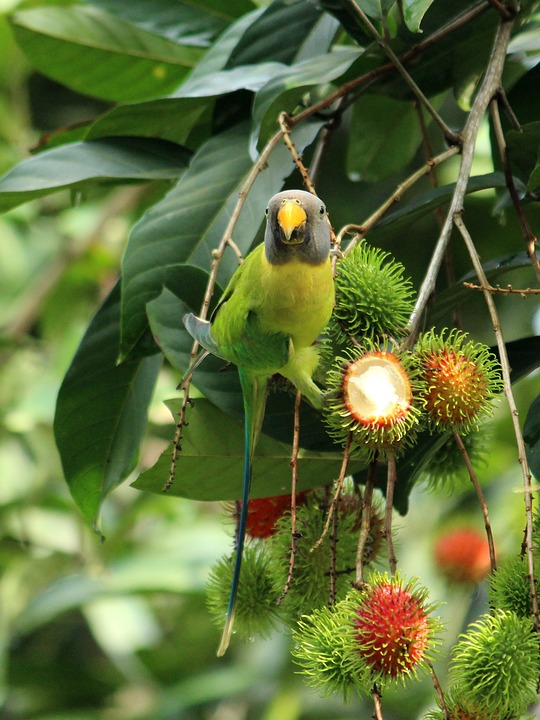Parrots are known for their colorful feathers and vibrant personalities, but one of their most fascinating traits is their ability to communicate through vocalizations. However, understanding what your parrot is trying to convey can be a challenging task. In this article, we will explore the different types of parrot vocalizations and their meanings, helping you understand your feathered friend better.
Types of Parrot Vocalizations:
1. Contact Calls: These are soft, repetitive sounds that parrots use to maintain social contact with their flock or their human companions. It’s a way for them to check in and ensure that everyone is nearby.
2. Alarm Calls: When a parrot senses danger or feels threatened, it will emit loud and shrill alarm calls. This is their way of warning the flock or their human caretakers of potential threats in the surroundings.
3. Vocal Play: Parrots are highly intelligent and curious creatures, and they often engage in vocal play. This includes making various sounds, experimenting with different pitches and tones, and even mimicking other sounds they hear in their environment.
4. Chatter Calls: Chatter calls are soft and rapid vocalizations that parrots use to communicate contentment or to show that they are comfortable in their surroundings. It’s a sign of relaxation and happiness.
5. Screaming Calls: Parrots often scream to express frustration, fear, or to seek attention. This can be a challenging behavior to deal with, but understanding the underlying reasons for the screaming can help address the issue effectively.
Decoding Parrot Vocalizations:
Understanding parrot vocalizations goes beyond just listening to the sounds they make. It involves paying attention to their body language, the context in which the vocalizations occur, the pitch, tone, and volume of the sounds, as well as the repetition and frequency of the vocalizations.
Common Parrot Vocalizations and Their Meanings:
1. Purring Sounds: Parrots make purring sounds when they are content and relaxed. It’s similar to a cat’s purr and is a sign that your parrot is happy and comfortable in its environment.
2. Whistling Tunes: Parrots are known for their ability to mimic sounds, including whistling tunes. Whistling can be a form of vocal play or a way for your parrot to get your attention.
3. Mimicking Human Speech: Parrots are exceptional mimics, and many can learn to mimic human speech. It’s their way of bonding with their human caretakers and can be a sign of affection and intelligence.
4. Squawking and Screeching: Squawking and screeching are often associated with distress, fear, or a cry for attention. It’s essential to investigate the underlying cause of these vocalizations and address any potential issues.
Establishing Communication with Your Parrot:
To establish effective communication with your parrot, it’s crucial to respond to their vocalizations. This can involve talking back to them, mimicking their sounds, or offering comfort and reassurance when they seem distressed. Additionally, you can encourage talking and mimicking by using positive reinforcement techniques and providing plenty of opportunities for your parrot to engage in vocal play.
Building trust and bonding with your parrot is also essential for effective communication. Spend quality time with your parrot, provide mental and physical stimulation, and create a safe and nurturing environment. Positive experiences and a strong bond will enhance your parrot’s willingness to communicate with you.
FAQs (Frequently Asked Questions):
1. Why does my parrot scream so much? Parrots may scream for various reasons, including fear, frustration, boredom, or seeking attention. Understanding the underlying cause and addressing it appropriately can help reduce excessive screaming.
2. How can I teach my parrot to mimic my voice? Teaching your parrot to mimic your voice requires patience, consistency, and positive reinforcement. Start by repeating simple words or phrases and rewarding your parrot when it mimics them. Gradually increase the complexity of the words and phrases.
3. Why does my parrot make purring sounds? Purring sounds in parrots are a sign of contentment and relaxation. It indicates that your parrot feels safe and comfortable in its surroundings.
4. Can parrots understand what they are saying? While parrots can mimic human speech, they may not always understand the meaning behind the words they say. However, they can associate certain words or phrases with specific actions or outcomes.
5. Should I ignore my parrot’s screaming behavior? Ignoring the screaming behavior of your parrot may not be the best approach. Instead, try to understand the underlying cause and address it appropriately. Ignoring the behavior may lead to increased frustration and further issues.
Conclusion:
Parrot vocalizations serve as a crucial means of communication for these intelligent creatures. By paying attention to their body language, context, and the different types of vocalizations, you can develop a deeper understanding of what your parrot is trying to convey. Remember, building a strong bond with your parrot through effective communication is key to a happy and fulfilling relationship. So, take the time to decode your parrot’s vocalizations, respond to them, and create a nurturing environment that encourages their natural communication skills.









